Crustal Structure Beneath the Arabian Shield Based on the Receiver Function Method
Abstract
1. Introduction
2. Data and Algorithms
2.1. Data Preprocessing
- Step 1. Calculate the cross-correlation, a(t) = ŝ(t)⊗d(t), where the symbol ⊗ denotes cross-correlation, d(t)-component of data to be deconvoluted, and ŝ(t) represents a wavelet in the time domain.
- Step 2. Determine the delay time kΔt of the maximum amplitude ak = max |a|, for which ak–amplitude a(t) with delay time kΔt.
- Step 3. Calculate the residual for the n-th iteration, rn(t) = d(t) − ak (t) ∗ δ(t − t0 − kΔt)
- Step 4. Update the data taking into account the residual, d(t) = rn(t).
2.2. Method for Estimation of Crustal Thickness and Vp/Vs Ratio
- Ps-P wave converted to the s wave during refraction at Moho;
- PpPs-P refracted to p at Moho, reflected as P from the free surface, and then reflected as converted s at Moho);
- PpSs (P refracted to p at Moho, reflected as converted S from the free surface, and then reflected as s at Moho);
- PsPs (P refracted to converted s at Moho, reflected as converted P from the free surface, and then reflected as converted s at Moho).
3. Results and Discussion
3.1. Discussion of H-k Stacking for Individual Stations
3.2. Moho Depth and Vp/Vs Ratio
4. Conclusions
Author Contributions
Funding
Conflicts of Interest
References
- Augustin, N.; Devey, C.W.; van der Zwan, F.M.; Feldens, P.; Tominaga, M.; Bantan, R.A.; Kwasnitschka, T. The Rifting to Spreading Transition in the Red Sea. Earth Planet Sci. Lett. 2014, 395, 217–230. [Google Scholar] [CrossRef]
- Martinez, F.; Cochran, J.R. Geothermal Measurements in the Northern Red Sea: Implications for Lithospheric Thermal Structure and Mode of Extension during Continental Rifting. J. Geophys. Res. Solid Earth 1989, 94, 12239–12265. [Google Scholar] [CrossRef]
- Stern, R.J.; Johnson, P.R. Constraining the Opening of the Red Sea: Evidence from the Neoproterozoic Margins and Cenozoic Magmatism for a Volcanic Rifted Margin. Geol. Setting Palaeoenvironment Archaeol. Red Sea 2018, 53–79. [Google Scholar] [CrossRef]
- El Khrepy, S.; Koulakov, I.; Gerya, T.; Al-Arifi, N.; Alajmi, M.S.; Qadrouh, A.N. Transition from Continental Rifting to Oceanic Spreading in the Northern Red Sea Area. Sci. Rep. 2021, 11, 1–7. [Google Scholar] [CrossRef]
- Schmidt, D.L.; Hadley, D.G.; Stoeser, D.B. Late Proterozoic Crustal History of the Arabian Shield, Southern Najd Province, Kingdom of Saudi Arabia. Evol. Miner. Arab.-Nubian Shield Proc. Symp. 1979, 2, 41–58. [Google Scholar] [CrossRef]
- Fleck, R.J.; Greenwood, W.R.; Hadley, D.G.; Anderson, R.E.; Schmidt, D.L.; Menard, H.W. Rubidium-Strontium Geochronology and Plate-Tectonic Evolution of the Southern Part of the Arabian Shield; Professional Paper; USGS: Reston, VA, USA, 1980. [CrossRef]
- Stern, R.J.; Johnson, P. Continental Lithosphere of the Arabian Plate: A Geologic, Petrologic, and Geophysical Synthesis. Earth Sci. Rev. 2010, 101, 29–67. [Google Scholar] [CrossRef]
- Brown, G.F. Tectonic Map of the Arabian Peninsula; Open-File Report 72-52; US Geological Survey: Reston, VA, USA, 1972. [CrossRef]
- Powers, R.W.; Ramirez, L.F.; Redmond, C.D.; Elberg, L.E., Jr. Geology of the Arabian Peninsula: Sedimentary Geology of Saudi Arabia; Professional Paper; United States Government Printing Office: Washington, DC, USA, 1966. [CrossRef]
- Koptev, A.; Gerya, T.; Calais, E.; Leroy, S.; Burov, E. Afar Triple Junction Triggered by Plume-Assisted Bi-Directional Continental Break-Up. Sci. Rep. 2018, 8, 1–7. [Google Scholar] [CrossRef]
- Bosworth, W.; Huchon, P.; McClay, K. The Red Sea and Gulf of Aden Basins. J. Afr. Earth Sci. 2005, 43, 334–378. [Google Scholar] [CrossRef]
- Cochran, J.R. Northern Red Sea: Nucleation of an Oceanic Spreading Center within a Continental Rift. Geochem. Geophys. Geosyst. 2005, 6, 3006. [Google Scholar] [CrossRef]
- Camp, V.E.; Roobol, M.J. Upwelling Asthenosphere beneath Western Arabia and Its Regional Implications. J. Geophys. Res. Solid Earth 1992, 97, 15255–15271. [Google Scholar] [CrossRef]
- Duncan, R.A.; Al-Amri, A.M. Timing and Composition of Volcanic Activity at Harrat Lunayyir, Western Saudi Arabia. J. Volcanol. Geotherm. Res. 2013, 260, 103–116. [Google Scholar] [CrossRef]
- Mukhopadhyay, M.; Mukhopadhyay, B.; Mogren, S.; Nandi, B.K.; Ibrahim, E. Regional Significance of Crustal and Sub-Crustal Rheological Heterogeneities beneath the Harrat Lunayyir and Their Continuity into the Neighboring Harrats, Western Saudi Arabia—Perspectives of the Afar Plume Activity. J. Afr. Earth Sci. 2022, 186, 104432. [Google Scholar] [CrossRef]
- Ebinger, C.J.; Sleep, N.H. Cenozoic Magmatism throughout East Africa Resulting from Impact of a Single Plume. Nature 1998, 395, 788–791. [Google Scholar] [CrossRef]
- El Khrepy, S.; Koulakov, I.; Al-Arifi, N. Crustal and Uppermost Mantle Structure beneath the Continental Rifting Area of the Gulf of Suez from Earthquake Tomography. Tectonophysics 2016, 668–669, 92–104. [Google Scholar] [CrossRef]
- Camp, V.E.; Hooper, P.R.; Roobol, M.J.; White, D.L. The Madinah Eruption, Saudi Arabia: Magma Mixing and Simultaneous Extrusion of Three Basaltic Chemical Types. Bull. Volcanol. 1987, 49, 489–508. [Google Scholar] [CrossRef]
- Pallister, J.S.; McCausland, W.A.; Jónsson, S.; Lu, Z.; Zahran, H.M.; el Hadidy, S.; Aburukbah, A.; Stewart, I.C.F.; Lundgren, P.R.; White, R.A.; et al. Broad Accommodation of Rift-Related Extension Recorded by Dyke Intrusion in Saudi Arabia. Nat. Geosci. 2010, 3, 705–712. [Google Scholar] [CrossRef]
- Koulakov, I.; El Khrepy, S.; Al-Arifi, N.; Kuznetsov, P.; Kasatkina, E. Structural Cause of a Missed Eruption in the Harrat Lunayyir Basaltic Field (Saudi Arabia) in 2009. Geology 2015, 43, 395–398. [Google Scholar] [CrossRef]
- Ebinger, C.; Belachew, M. Active Passive Margins. Nat. Geosci. 2010, 3, 670–671. [Google Scholar] [CrossRef]
- Ritsema, J.; van Heijst, H.J.; Woodhouse, J.H. Complex Shear Wave Velocity Structure Imaged beneath Africa and Iceland. Science 1999, 286, 1925–1931. [Google Scholar] [CrossRef]
- Rodgers, A.J.; Walter, W.R.; Mellors, R.J.; Al-Amri, A.M.S.; Zhang, Y.S. Lithospheric Structure of the Arabian Shield and Platform from Complete Regional Waveform Modelling and Surface Wave Group Velocities. Geophys. J. Int. 1999, 138, 871–878. [Google Scholar] [CrossRef]
- Ritsema, J.; van Heijst, H. New Seismic Model of the Upper Mantle beneath Africa. Geology 2000, 28, 63–66. [Google Scholar] [CrossRef]
- Debayle, E.; Lévêque, J.J.; Cara, M. Seismic Evidence for a Deeply Rooted Low-Velocity Anomaly in the Upper Mantle beneath the Northeastern Afro/Arabian Continent. Earth Planet. Sci. Lett. 2001, 193, 423–436. [Google Scholar] [CrossRef]
- Sebai, A.; Stutzmann, E.; Montagner, J.P.; Sicilia, D.; Beucler, E. Anisotropic Structure of the African Upper Mantle from Rayleigh and Love Wave Tomography. Phys. Earth Planet. Inter. 2006, 155, 48–62. [Google Scholar] [CrossRef]
- Montagner, J.P.; Marty, B.; Stutzmann, E.; Sicilia, D.; Cara, M.; Pik, R.; Lévêque, J.J.; Roult, G.; Beucler, E.; Debayle, E. Mantle Upwellings and Convective Instabilities Revealed by Seismic Tomography and Helium Isotope Geochemistry beneath Eastern Africa. Geophys. Res. Lett. 2007, 34. [Google Scholar] [CrossRef]
- Chang, S.J.; van der Lee, S. Mantle Plumes and Associated Flow beneath Arabia and East Africa. Earth Planet. Sci. Lett. 2011, 302, 448–454. [Google Scholar] [CrossRef]
- Ekström, G. A Global Model of Love and Rayleigh Surface Wave Dispersion and Anisotropy, 25-250 s. Geophys. J. Int. 2011, 187, 1668–1686. [Google Scholar] [CrossRef]
- Park, Y.; Nyblade, A.A.; Rodgers, A.J.; Al-Amri, A.; Park, Y.; Nyblade, A.A.; Rodgers, A.J.; Al-Amri, A. S Wave Velocity Structure of the Arabian Shield Upper Mantle from Rayleigh Wave Tomography. Geochem. Geophys. Geosystems 2008, 9, 1213. [Google Scholar] [CrossRef]
- Yao, Z.; Mooney, W.D.; Zahran, H.M.; Youssef, S.E.H. Upper Mantle Velocity Structure beneath the Arabian Shield from Rayleigh Surface Wave Tomography and Its Implications. J. Geophys. Res. Solid Earth 2017, 122, 6552–6568. [Google Scholar] [CrossRef]
- Ritzwoller, M.H.; Barmin, M.P.; Villaseñor, A.; Levshin, A.L.; Engdahl, E.R. Pn and Sn Tomography across Eurasia to Improve Regional Seismic Event Locations. Tectonophysics 2002, 358, 39–55. [Google Scholar] [CrossRef]
- Al-Lazki, A.I.; Sandvol, E.; Seber, D.; Barazangi, M.; Turkelli, N.; Mohamad, R. Pn Tomographic Imaging of Mantle Lid Velocity and Anisotropy at the Junction of the Arabian, Eurasian and African Plates. Geophys. J. Int. 2004, 158, 1024–1040. [Google Scholar] [CrossRef]
- Koulakov, I. High-Frequency P and S Velocity Anomalies in the Upper Mantle beneath Asia from Inversion of Worldwide Traveltime Data. J. Geophys. Res. Solid Earth 2011, 116, 4301. [Google Scholar] [CrossRef]
- Koulakov, I.; Burov, E.; Cloetingh, S.; El Khrepy, S.; Al-Arifi, N.; Bushenkova, N. Evidence for Anomalous Mantle Upwelling beneath the Arabian Platform from Travel Time Tomography Inversion. Tectonophysics 2016, 667, 176–188. [Google Scholar] [CrossRef]
- Stork, A.L.; Stuart, G.W.; Henderson, C.M.; Keir, D.; Hammond, J.O.S. Uppermost Mantle (Pn) Velocity Model for the Afar Region, Ethiopia: An Insight into Rifting Processes. Geophys. J. Int. 2013, 193, 321–328. [Google Scholar] [CrossRef]
- Hammond, J.O.S.; Kendall, J.M.; Stuart, G.W.; Ebinger, C.J.; Bastow, I.D.; Keir, D.; Ayele, A.; Belachew, M.; Goitom, B.; Ogubazghi, G.; et al. Mantle Upwelling and Initiation of Rift Segmentation beneath the Afar Depression. Geology 2013, 41, 635–638. [Google Scholar] [CrossRef]
- Korostelev, F.; Basuyau, C.; Leroy, S.; Tiberi, C.; Ahmed, A.; Stuart, G.W.; Keir, D.; Rolandone, F.; al Ganad, I.; Khanbari, K.; et al. Crustal and Upper Mantle Structure beneath South-Western Margin of the Arabian Peninsula from Teleseismic Tomography. Geochem. Geophys. Geosystems 2014, 15, 2850–2864. [Google Scholar] [CrossRef]
- Benoit, M.H.; Nyblade, A.A.; VanDecar, J.C.; Gurrola, H. Upper Mantle P Wave Velocity Structure and Transition Zone Thickness beneath the Arabian Shield. Geophys. Res. Lett. 2003, 30. [Google Scholar] [CrossRef]
- Abdelwahed, M.F.; El-Masry, N.; Moufti, M.R.; Kenedi, C.L.; Zhao, D.; Zahran, H.; Shawali, J. Imaging of Magma Intrusions beneath Harrat Al-Madinah in Saudi Arabia. J. Asian Earth Sci. 2016, 120, 17–28. [Google Scholar] [CrossRef]
- Vinnik, L.; Kumar, M.R.; Kind, R.; Farra, V. Super-Deep Low-Velocity Layer beneath the Arabian Plate. Geophys. Res. Lett. 2003, 30, 1415. [Google Scholar] [CrossRef]
- El Khrepy, S.; Koulakov, I.; Al-Arifi, N.; Petrunin, A.G. Seismic Structure beneath the Gulf of Aqaba and Adjacent Areas Based on the Tomographic Inversion of Regional Earthquake Data. Solid Earth 2016, 7, 965–978. [Google Scholar] [CrossRef]
- Mooney, W.D.; Gettings, M.E.; Blank, H.R.; Healy, J.H. Saudi Arabian Seismic-Refraction Profile: A Traveltime Interpretation of Crustal and Upper Mantle Structure. Tectonophysics 1985, 111, 173–246. [Google Scholar] [CrossRef]
- Gettings, M.E.; Blank, H.R.; Mooney, W.D.; Healey, J.H. Crustal Structure of Southwestern Saudi Arabia. J. Geophys. Res. Solid Earth 1986, 91, 6491–6512. [Google Scholar] [CrossRef]
- El-Isa, Z.; Mechie, J.; Prodehl, C.; Makris, J.; Rihm, R. A Crustal Structure Study of Jordan Derived from Seismic Refraction Data. Tectonophysics 1987, 138, 235–253. [Google Scholar] [CrossRef]
- Al-Lazki, A.I.; Seber, D.; Sandvol, E.; Barazangi, M. A Crustal Transect across the Oman Mountains on the Eastern Margin of Arabia. GeoArabia 2002, 7, 47–78. [Google Scholar] [CrossRef]
- Mechie, J.; Ben-Avraham, Z.; Weber, M.H.; Götze, H.J.; Koulakov, I.; Mohsen, A.; Stiller, M. The Distribution of Moho Depths beneath the Arabian Plate and Margins. Tectonophysics 2013, 609, 234–249. [Google Scholar] [CrossRef]
- Tang, Z. Multi-Scale Inference of Lithospheric Seismic Structure in Saudi Arabia. Ph.D. Thesis, Kaust, Jeddah, Saudi Arabia, 2018. [Google Scholar]
- Al-Damegh, K.; Sandvol, E.; Barazangi, M. Crustal Structure of the Arabian Plate: New Constraints from the Analysis of Teleseismic Receiver Functions. Earth Planet Sci. Lett. 2005, 231, 177–196. [Google Scholar] [CrossRef]
- Tkalčić, H.; Pasyanos, M.E.; Rodgers, A.J.; Gök, R.; Walter, W.R.; Al-Amri, A. A Multistep Approach for Joint Modeling of Surface Wave Dispersion and Teleseismic Receiver Functions: Implications for Lithospheric Structure of the Arabian Peninsula. J. Geophys. Res. Solid Earth 2006, 111. [Google Scholar] [CrossRef]
- Blanchette, A.R.; Klemperer, S.L.; Mooney, W.D.; Zahran, H.M. Thickness of the Saudi Arabian Crust. Thick. Saudi Arab. 2020. [Google Scholar] [CrossRef]
- Tang, Z.; Julià, J.; Zahran, H.; Mai, P.M. The Lithospheric Shear-Wave Velocity Structure of Saudi Arabia: Young Volcanism in an Old Shield. Tectonophysics 2016, 680, 8–27. [Google Scholar] [CrossRef]
- Tang, Z.; Mai, P.M.; Julià, J.; Zahran, H. Shear Velocity Structure Beneath Saudi Arabia From the Joint Inversion of P and S Wave Receiver Functions, and Rayleigh Wave Group Velocity Dispersion Data. J. Geophys. Res. Solid Earth 2019, 124, 4767–4787. [Google Scholar] [CrossRef]
- Mai, P.M.; Julià, J.; Tang, Z. Crustal and upper-mantle structure beneath Saudi Arabia from receiver functions and surface wave analysis. In Geological Setting, Palaeoenvironment and Archaeology of the Red Sea; Springer: Berlin/Heidelberg, Germany, 2018; pp. 307–322. [Google Scholar] [CrossRef]
- Julià, J.; Ammon, C.J.; Herrmann, R.B. Lithospheric Structure of the Arabian Shield from the Joint Inversion of Receiver Functions and Surface-Wave Group Velocities. Tectonophysics 2003, 371, 1–21. [Google Scholar] [CrossRef]
- Hansen, S.E.; Rodgers, A.J.; Schwartz, S.Y.; Al-Amri, A.M.S. Imaging Ruptured Lithosphere beneath the Red Sea and Arabian Peninsula. Earth Planet. Sci. Lett. 2007, 259, 256–265. [Google Scholar] [CrossRef]
- Liu, L.; Tong, S.; Li, S.; Qaysi, S. Sp Receiver-Function Images of African and Arabian Lithosphere: Survey of Newly Available Broadband Data. Seismol. Res. Lett. 2020, 91, 1813–1819. [Google Scholar] [CrossRef]
- Al-Amri, A.M.S. The Crustal and Upper-Mantle Structure of the Interior Arabian Platform. Geophys. J. Int. 1999, 136, 421–430. [Google Scholar] [CrossRef]
- Al-Amri, A.M.; Gharib, A.A. Lithospheric Seismic Structure of the Eastern Region of the Arabian Peninsula. J. Geodyn. 2000, 29, 125–139. [Google Scholar] [CrossRef]
- Sandvol, E.; Seber, D.; Barazangi, M.; Vernon, F.; Mellors, R.; Al-Amri, A. Lithospheric Seismic Velocity Discontinuities beneath the Arabian Shield. Geophys. Res. Lett. 1998, 25, 2873–2876. [Google Scholar] [CrossRef]
- Hosny, A.; Alraddadi, W.; Tarabulsi, Y. Moho Undulations and High Poisson’s Ratio beneath Volcanic Areas, West of Saudi Arabia: Indication of Asymmetric Lithospheric Uplift. J. Seismol. 2022, 26, 301–318. [Google Scholar] [CrossRef]
- Endo, E.; Zahran, H.; Nofal, H.; Hadidy, S. The Saudi National Seismic Network. Seismol. Res. Lett. 2007, 78, 439–445. [Google Scholar] [CrossRef]
- International Seismological Centre. On-Line Bulletin. 2022. Available online: https://doi.org/10.31905/D808B830 (accessed on 15 March 2022).
- Kennett, B.L.N.; Engdah, E.R. Traveltimes for Global Earthquake Location and Phase Identification. Geophys. J. Int. 1991, 105, 429–465. [Google Scholar] [CrossRef]
- Ligorría, J.P.; Ammon, C.J. Iterative Deconvolution and Receiver-Function Estimation. Bull. Seismol. Soc. Am. 1999, 89, 1395–1400. [Google Scholar] [CrossRef]
- Berkhout, A.J. Least-Squares Inverse Filtering and Wavelet Deconvolution. Geophysics 1977, 42, 1369–1383. [Google Scholar] [CrossRef]
- Zhu, L.; Kanamori, H. Moho Depth Variation in Southern California from Teleseismic Receiver Functions. J. Geophys. Res. Solid Earth 2000, 105, 2969–2980. [Google Scholar] [CrossRef]
- Downs, D.T.; Stelten, M.E.; Champion, D.E.; Dietterich, H.R.; Nawab, Z.; Zahran, H.; Hassan, K.; Shawali, J. Volcanic History of the Northernmost Part of the Harrat Rahat Volcanic Field, Saudi Arabia. Geosphere 2018, 14, 1253–1282. [Google Scholar] [CrossRef]
- Murcia, H.; Németh, K.; El-Masry, N.N.; Lindsay, J.M.; Moufti, M.R.H.; Wameyo, P.; Cronin, S.J.; Smith, I.E.M.; Kereszturi, G. The Al-Du’aythah Volcanic Cones, Al-Madinah City: Implications for Volcanic Hazards in Northern Harrat Rahat, Kingdom of Saudi Arabia. Bull. Volcanol. 2015, 77, 1–19. [Google Scholar] [CrossRef]
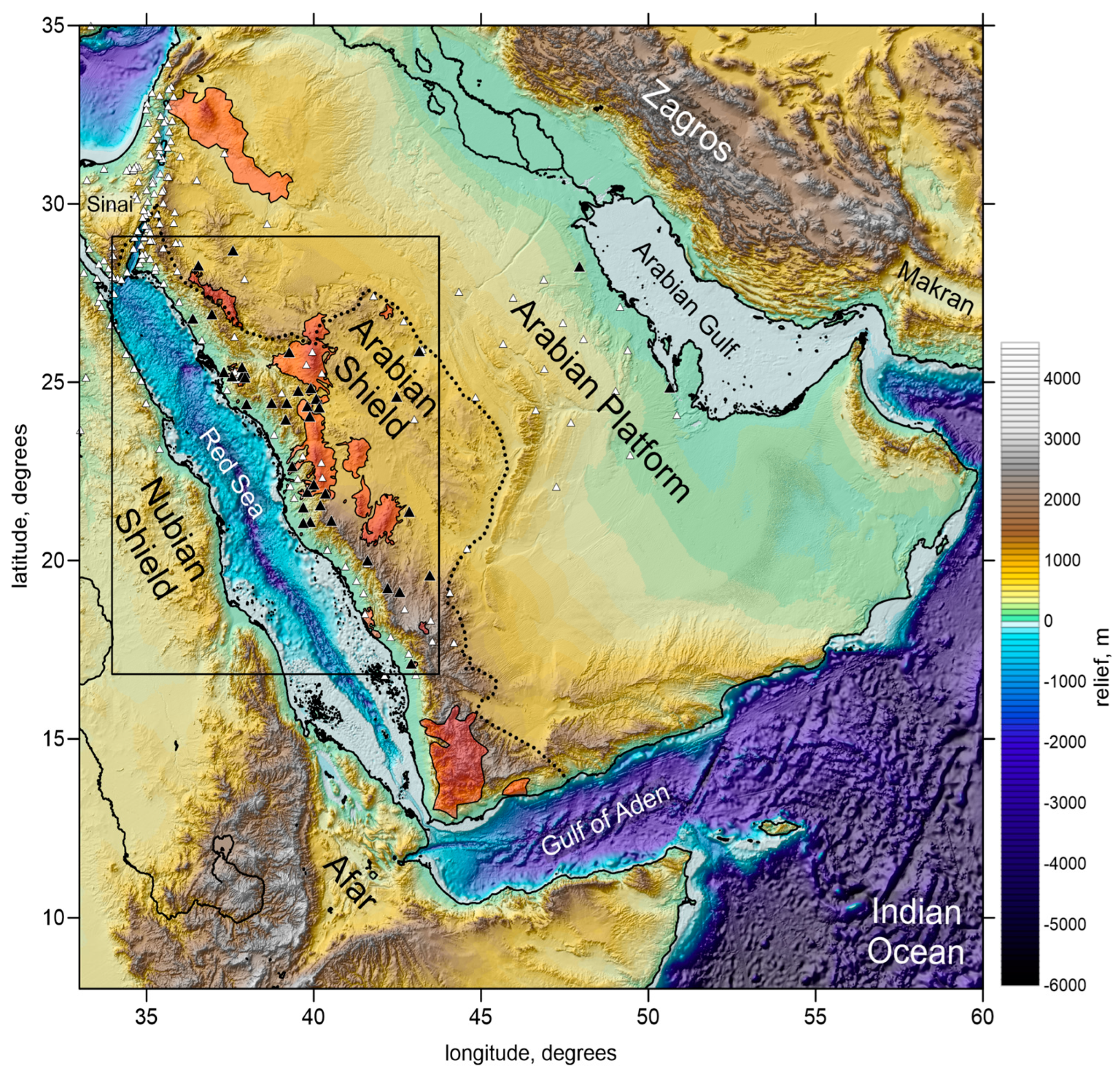

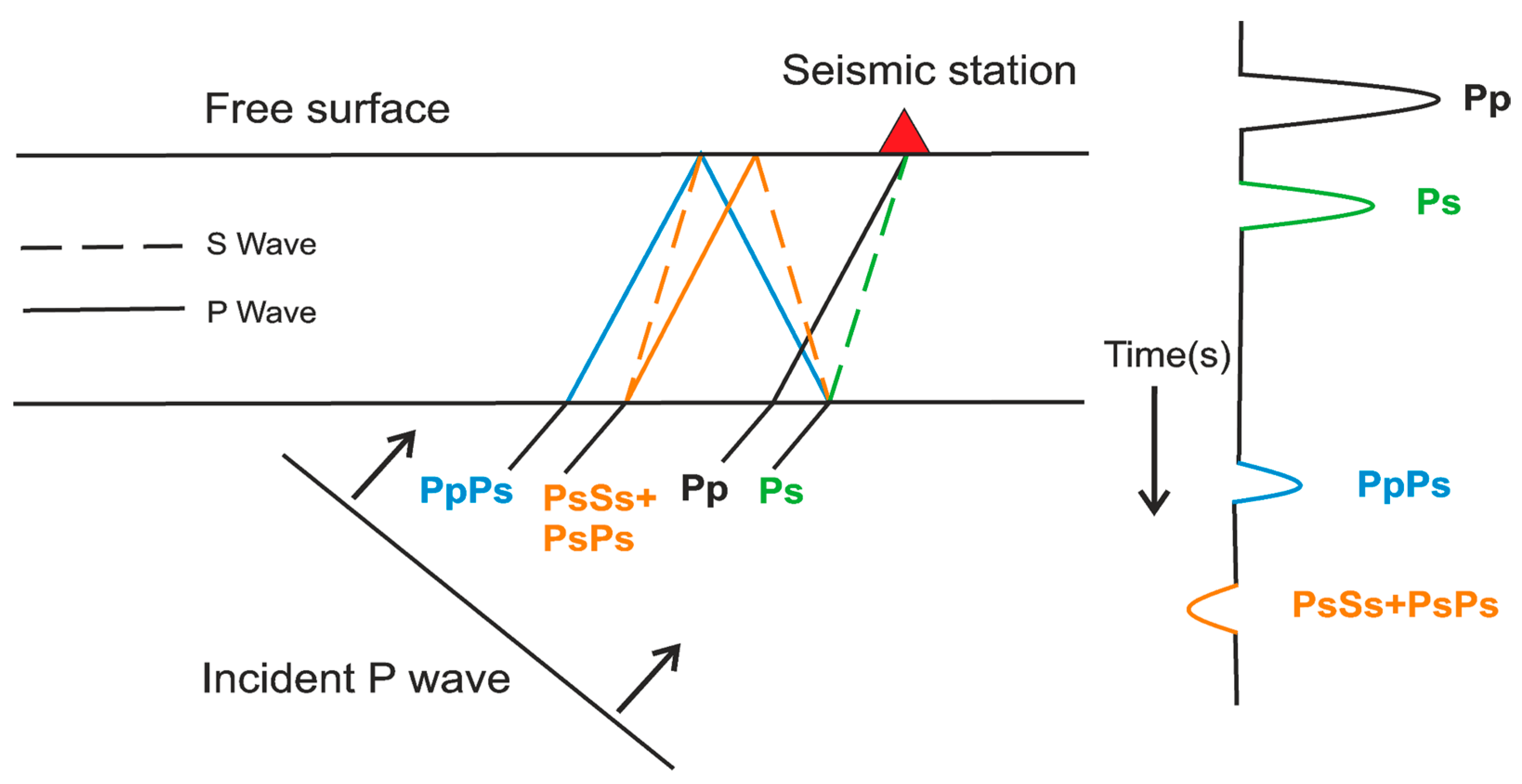
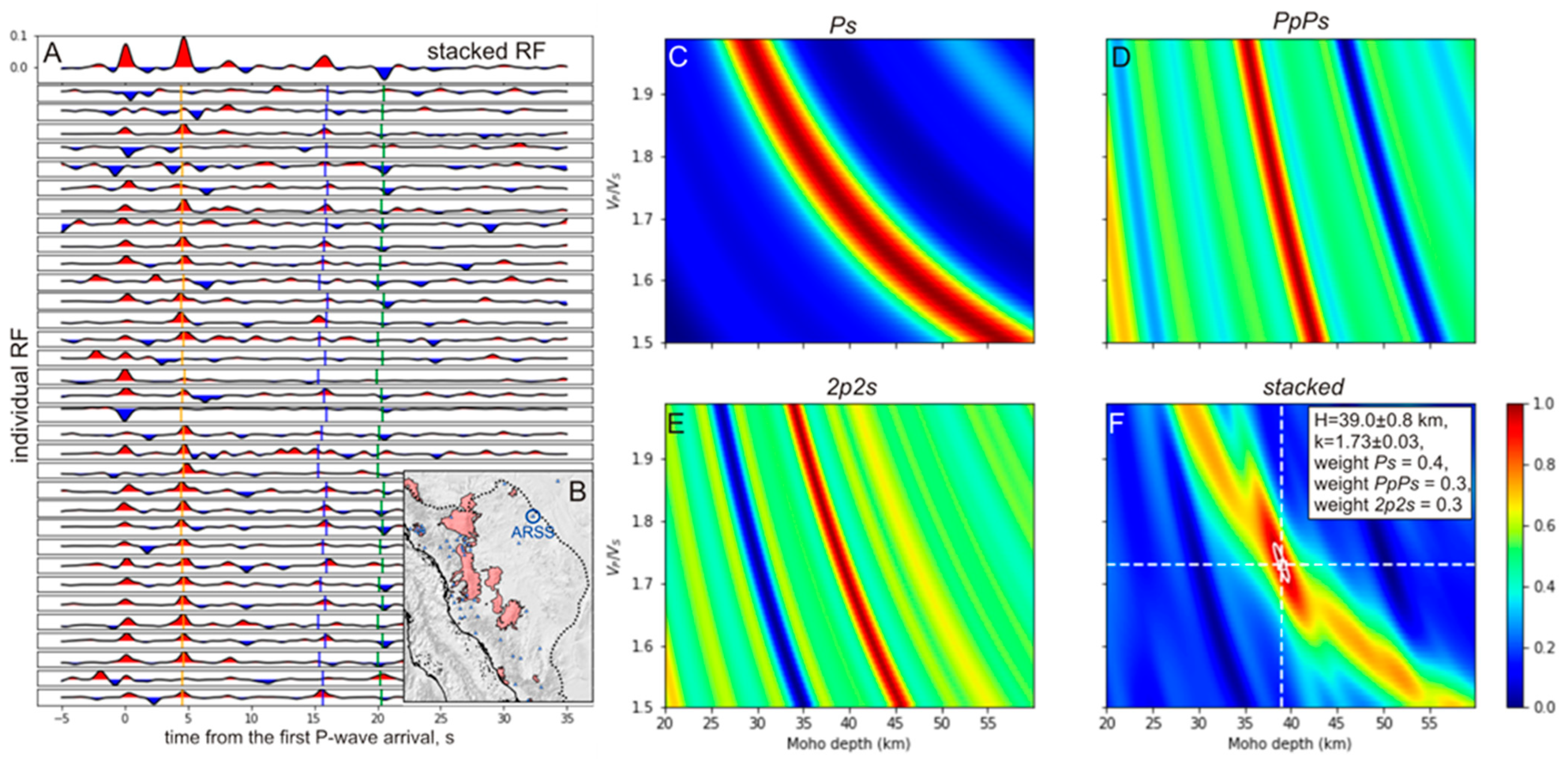
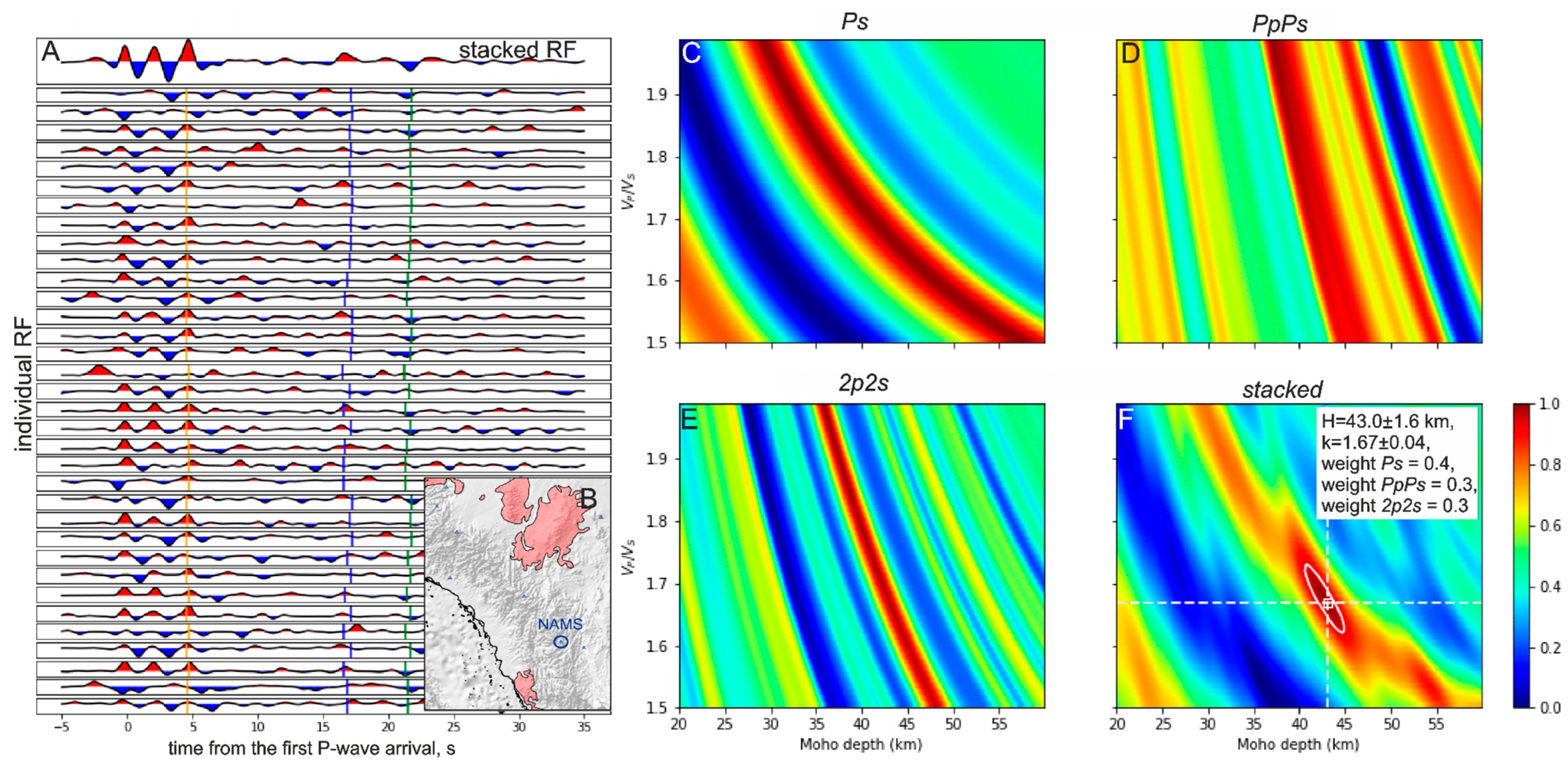
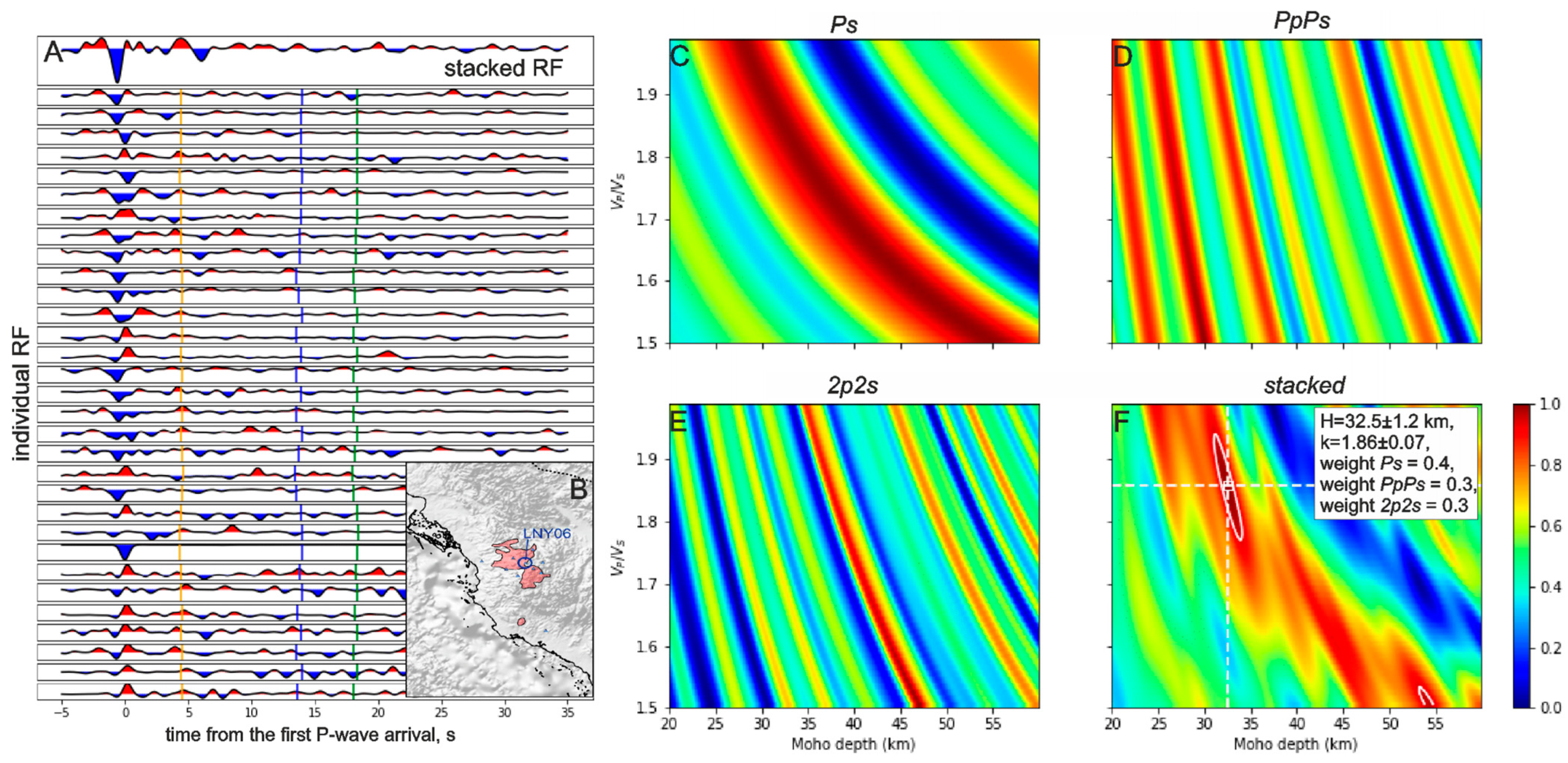
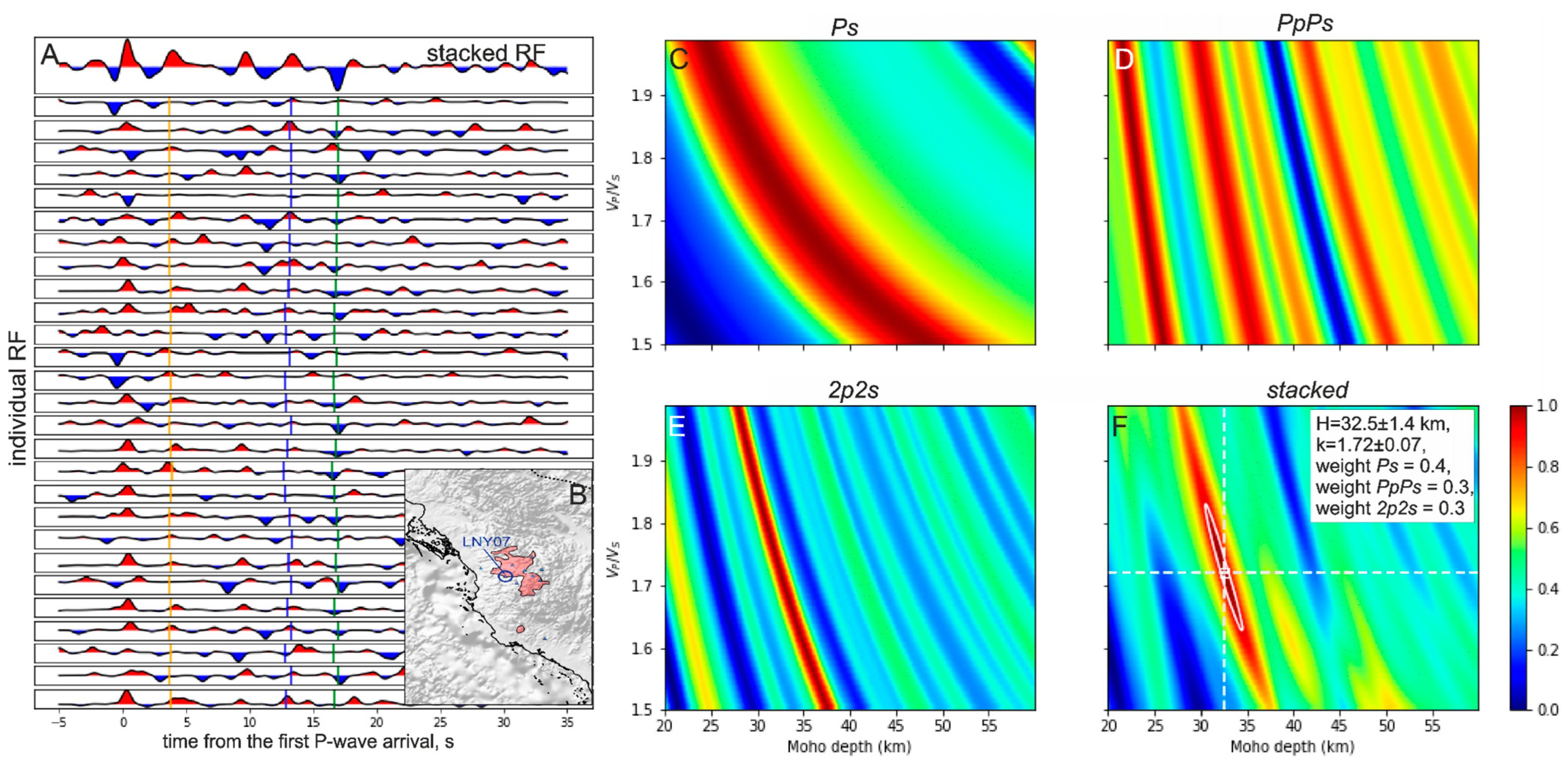


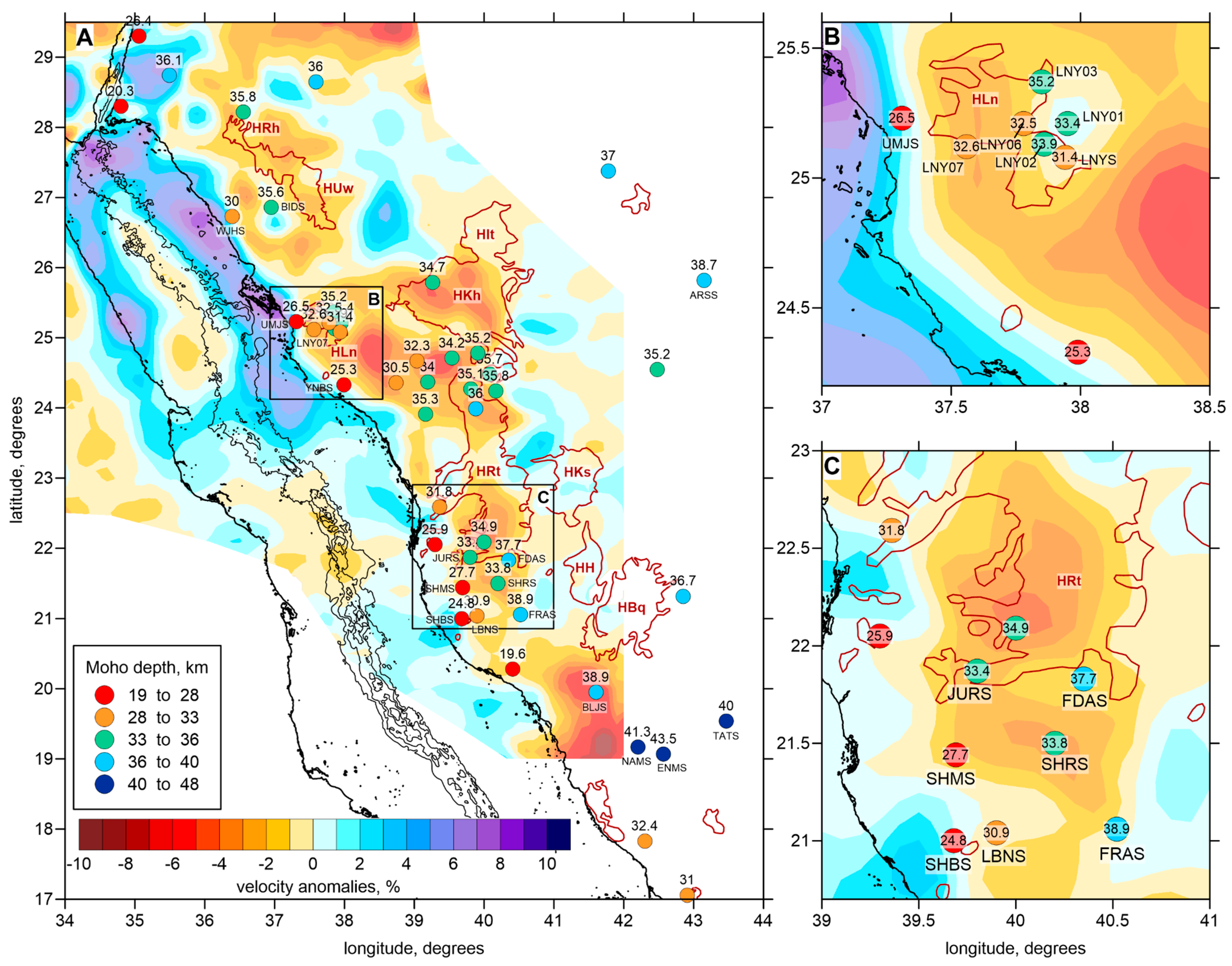


| Station Name | Latitude | Longitude | Crustal Thickness (km) | VP/VS | Location |
|---|---|---|---|---|---|
| AFFS | 24.55 | 42.48 | 35.2 | 1.76 | Shield |
| ARSS | 25.82 | 43.15 | 38.7 | 1.74 | Shield |
| BIDS | 26.86 | 36.95 | 35.6 | 1.67 | Shield |
| BLJS | 19.95 | 41.60 | 38.9 | 1.70 | Shield |
| ENMS | 19.07 | 42.57 | 43.5 | 1.71 | Shield |
| JLOS | 28.74 | 35.49 | 36.1 | 1.74 | Shield |
| FDAS | 21.83 | 40.35 | 37.7 | 1.65 | Harrat–Rahat |
| FRAS | 21.06 | 40.52 | 38.9 | 1.73 | Shield |
| FRJS | 22.59 | 39.36 | 31.8 | 1.61 | Coastal plain |
| JAZS | 17.06 | 42.91 | 31.0 | 1.67 | Coastal plain |
| BTHS | 24.05 | 50.85 | 46.0 | 1.68 | Platform |
| JURS | 21.87 | 39.80 | 33.4 | 1.68 | Harrat–Rahat |
| KFJS | 28.19 | 47.94 | 46.8 | 1.81 | Platform |
| KBRS | 25.79 | 39.26 | 34.7 | 1.76 | Harrat–Khaybar |
| LBNS | 21.04 | 39.90 | 30.9 | 1.75 | Coastal plain |
| LTHS | 20.28 | 40.41 | 19.6 | 1.84 | Coastal plain |
| LNY01 | 25.21 | 37.95 | 33.4 | 1.78 | Harrat–Lunayyir |
| LNY02 | 25.13 | 37.86 | 33.9 | 1.78 | Harrat–Lunayyir |
| LNY03 | 25.37 | 37.85 | 35.2 | 1.67 | Harrat–Lunayyir |
| LNY06 | 25.21 | 37.78 | 32.5 | 1.86 | Harrat–Lunayyir |
| LNY07 | 25.12 | 37.56 | 32.6 | 1.74 | Harrat–Lunayyir |
| LNYS | 25.08 | 37.94 | 31.4 | 1.83 | Harrat–Lunayyir |
| MDRS | 22.09 | 40.00 | 34.9 | 1.73 | Harrat–Rahat |
| NAMS | 19.17 | 42.20 | 41.3 | 1.68 | Shield |
| QLBS | 28.65 | 37.59 | 36.0 | 1.75 | Shield |
| RHT01 | 24.27 | 39.81 | 35.1 | 1.79 | Harrat–Rahat |
| RHT02 | 24.48 | 40.08 | 35.7 | 1.73 | Harrat–Rahat |
| RHT03 | 24.24 | 40.17 | 35.8 | 1.73 | Harrat–Rahat |
| RHT04 | 23.99 | 39.88 | 36.0 | 1.74 | Harrat–Rahat |
| RHT05 | 23.909 | 39.16 | 35.3 | 1.70 | Shield |
| RHT06 | 24.37 | 39.19 | 34.0 | 1.70 | Shield |
| RHT07 | 24.67 | 39.04 | 32.3 | 1.69 | Harrat–Rahat |
| RHT08 | 24.71 | 39.54 | 34.2 | 1.78 | Harrat–Rahat |
| RHT09 | 24.78 | 39.91 | 35.2 | 1.73 | Harrat–Rahat |
| RYNS | 21.32 | 42.85 | 36.7 | 1.74 | Shield |
| RSHS | 28.30 | 34.80 | 20.3 | 1.77 | Coastal plain |
| SHBS | 21.00 | 39.68 | 24.8 | 1.80 | Coastal plain |
| SHMS | 21.44 | 39.69 | 27.7 | 1.75 | Coastal plain |
| SHRS | 21.50 | 40.20 | 33.8 | 1.72 | Shield |
| SLWS | 24.80 | 50.64 | 37.7 | 1.88 | Platform |
| TATS | 19.54 | 43.47 | 40.0 | 1.79 | Shield |
| TBKS | 28.22 | 36.55 | 35.8 | 1.77 | Platform |
| UMJS | 25.23 | 37.31 | 26.5 | 1.62 | Coastal plain |
| WJHS | 26.73 | 36.39 | 30.0 | 1.66 | Coastal plain |
| YNBS | 24.33 | 37.99 | 25.3 | 1.88 | Coastal plain |
| YOBS | 24.36 | 38.74 | 30.5 | 1.77 | Coastal plain |
| KHLS | 22.05 | 39.30 | 25.9 | 1.82 | Coastal plain |
| DRBS | 17.83 | 42.30 | 32.4 | 1.69 | Coastal plain |
| BOQS | 25.87 | 49.38 | 47.6 | 1.64 | Platform |
| HILS | 27.38 | 41.78 | 37.0 | 1.80 | Shield |
| HQLS | 29.30 | 35.06 | 26.4 | 1.79 | Platform |
Publisher’s Note: MDPI stays neutral with regard to jurisdictional claims in published maps and institutional affiliations. |
© 2022 by the authors. Licensee MDPI, Basel, Switzerland. This article is an open access article distributed under the terms and conditions of the Creative Commons Attribution (CC BY) license (https://creativecommons.org/licenses/by/4.0/).
Share and Cite
Qaysi, S.I.; Ivanov, A.; Koulakov, I.; Al Arifi, N.; El Khrepy, S.; Jakovlev, A. Crustal Structure Beneath the Arabian Shield Based on the Receiver Function Method. Geosciences 2022, 12, 399. https://doi.org/10.3390/geosciences12110399
Qaysi SI, Ivanov A, Koulakov I, Al Arifi N, El Khrepy S, Jakovlev A. Crustal Structure Beneath the Arabian Shield Based on the Receiver Function Method. Geosciences. 2022; 12(11):399. https://doi.org/10.3390/geosciences12110399
Chicago/Turabian StyleQaysi, Saleh Ismail, Andrei Ivanov, Ivan Koulakov, Nassir Al Arifi, Sami El Khrepy, and Andrey Jakovlev. 2022. "Crustal Structure Beneath the Arabian Shield Based on the Receiver Function Method" Geosciences 12, no. 11: 399. https://doi.org/10.3390/geosciences12110399
APA StyleQaysi, S. I., Ivanov, A., Koulakov, I., Al Arifi, N., El Khrepy, S., & Jakovlev, A. (2022). Crustal Structure Beneath the Arabian Shield Based on the Receiver Function Method. Geosciences, 12(11), 399. https://doi.org/10.3390/geosciences12110399







